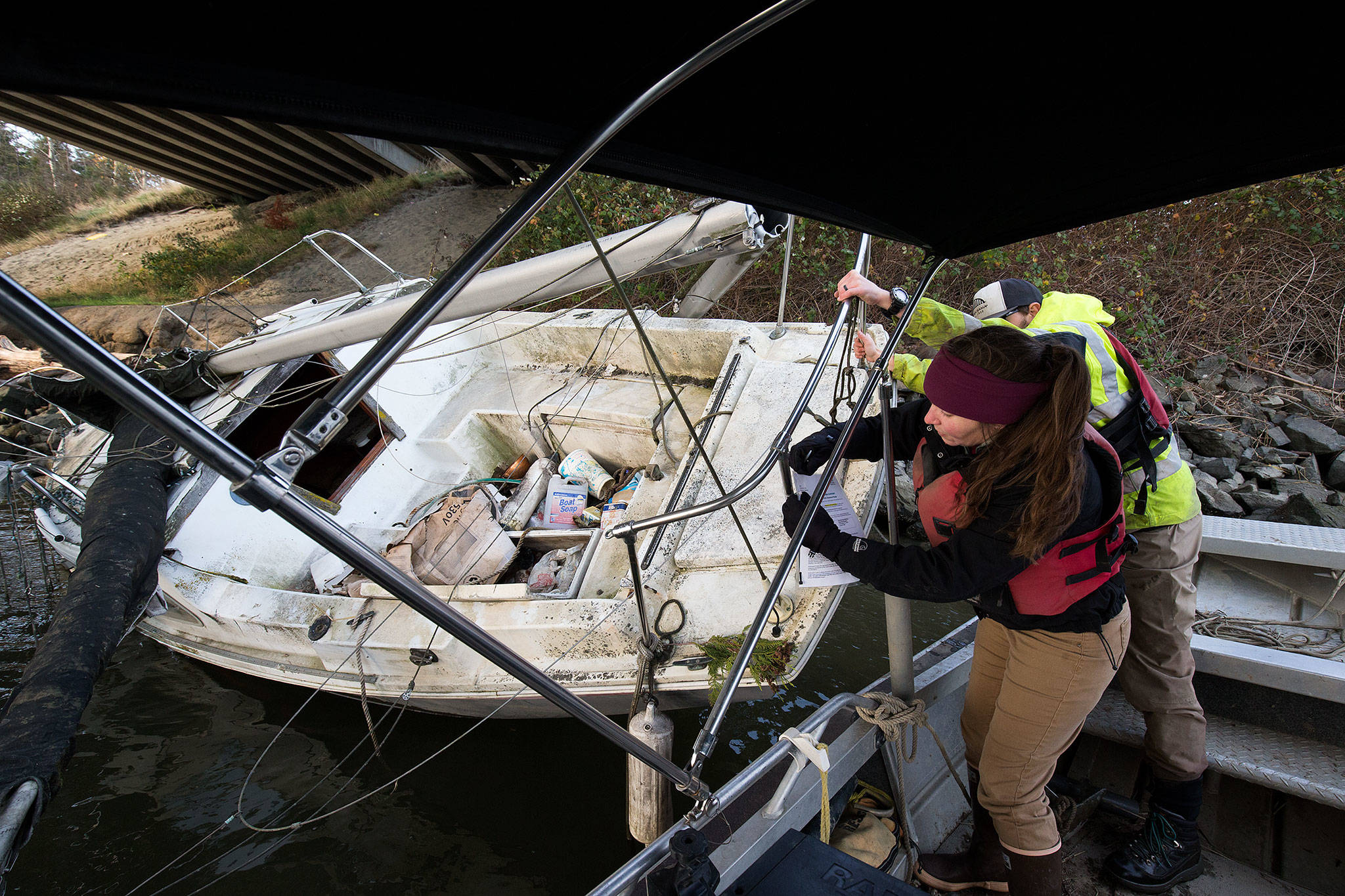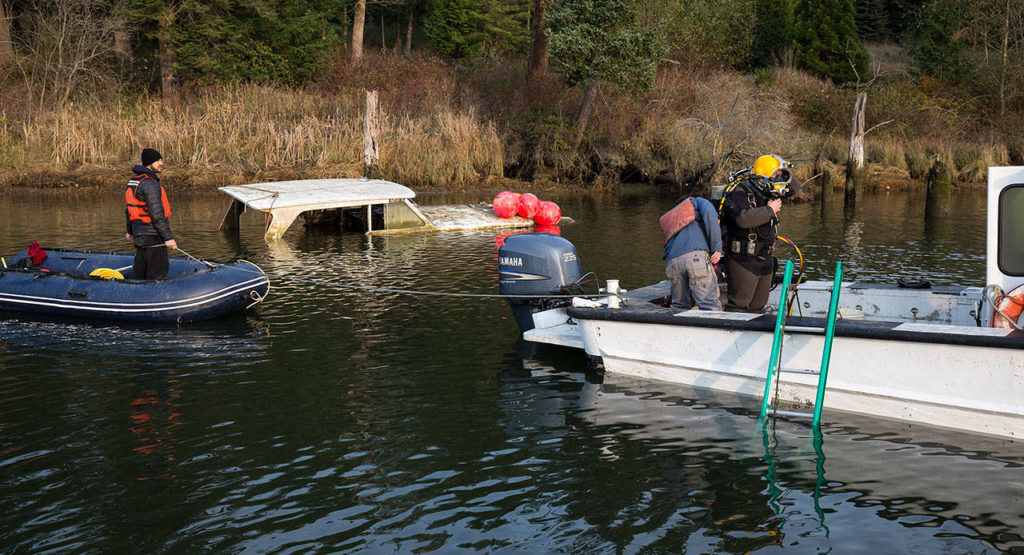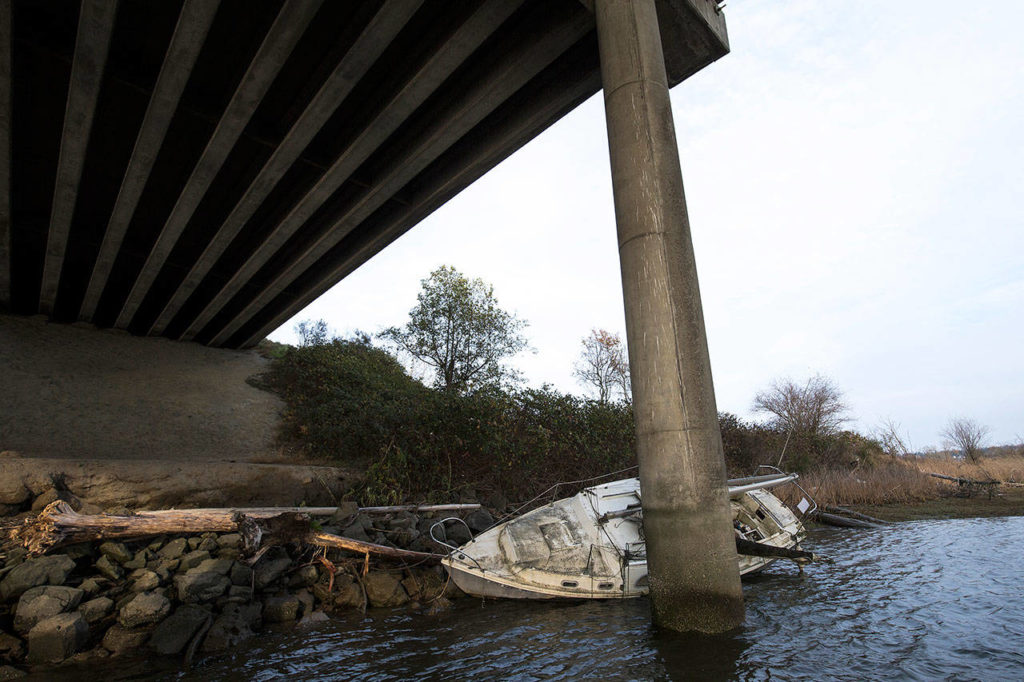EVERETT — A dive crew prepped a battered Fairliner to be towed from the muck of Ebey Slough one afternoon last week.
Bright orange buoys surrounded the 38-foot-long boat with a fiberglass hull. With luck, the crew would return in the early a.m., at high tide, to float the abandoned boat from the shallow waterway.
“It’s a challenging one,” said Tim Jewell , whose company Enviro-Tech Diving was carrying out the work and who stood on a nearby boat. “Logistically, this one is the toughest because it’s so shallow. I figure it’s got 10,000 pounds of mud in there.”
Snohomish County recently contracted Jewell’s company to haul off five abandoned boats from local waterways. Another two removals have gone out to bid.
Tidying up the Snohomish River and surrounding sloughs is a ceaseless effort, at times with little headway in sight.
Typically, that work has been up to the state Department of Natural Resources. Since 2003, the state has removed 105 abandoned vessels in Snohomish County alone, and more than 800 statewide, said Troy Wood, who manages that program.
More turn up all the time.
The DNR’s vessels of concern list numbered 161 as of Friday, 18 of them in Snohomish County, Wood said.
They include the Hannah Marie, a 100-foot fishing vessel formerly known as the Midas. It’s tied up on a muddy bank near the I-5 bridge over the Snohomish River. The owner has started an online fundraiser seeking $100,000 for repairs.
Earlier this month, a a 60-foot wooden cabin cruiser smacked into the supports for the Highway 529 bridge and sank.
Don’t expect much to happen with either one any time soon.
The DNR program’s two-year budget is just about sunk. It started with about $2.4 million, largely from registration fees for recreational and commercial vessels. More funding isn’t due to arrive until July.
“We effectively don’t have any money to do any vessel removals at this point,” Wood said.
A $50,000 state grant, however, is helping Snohomish County take the lead on the upcoming work to clean up the sloughs. The county also put in $8,000.
“This is the first time that the county is operating as the local, authorized entity to remove these boats,” said Kathleen Pozarycki, a senior county planner who works on surface water and marine issues.
Getting rid of discarded sailboats, cabin cruisers and other craft could complement ongoing actions to restore the Snohomish River estuary. It’s part of a wider push that includes flooding hundreds of acres on Smith Island this summer, along with similar projects to benefit chinook salmon and other species in the tidal environment.
“The boats impact the habitat because in some cases they leach chemicals and hydrocarbons and fuel,” Pozarycki said. “We want to get those out of the water to improve water quality and fish habitat.”
Erik Stockdale, a county surface water planning manager, explained how lead, copper and chemical agents work their way into the ecosystem. The substances are designed to kill invertebrates that try to attach to boat hulls.
“Some boats have an anti-fouling paint on the bottom, especially some of the older boats that are lead-based paints and have other types of insecticides in them,” Stockdale said. “When these boats bottom out, the mudflat surface that the boats get hung up on are habitat for invertebrates that live in the mud.”
The removal process includes testing for asbestos and other hazardous materials.
Last week, Pozarycki headed out on Steamboat Slough with Luke Hanna a biologist with the surface water management program. They posted a 30-day notice on a sailboat washed up under the I-5 bridge.
During storms a few weeks ago, the sailboat floated an estimated three miles downstream from where it was first spotted.
“It shows you how dynamic the estuary is,” Hanna said.
The county also is preparing to take custody of a 30-foot sailboat near the Port of Everett’s Mount Baker Terminal.
State officials can try to track down delinquent boat owners to recoup salvage costs. For smaller craft, they send letters demanding payment and can refer debts to collection agencies.
The DNR can pursue larger cases in court, as removal costs can run into hundreds of thousands of dollars.
Noah Haglund: 425-339-3465; nhaglund@heraldnet.com. Twitter: @NWhaglund.
What to do with a broken-down boat
Washington’s Department of Natural Resources offers a program that allows owners to surrender boats in disrepair before they become problems in the water. The Vessel Turn-In Program is available for boats less than 45 feet long whose owners who can’t afford disposal costs.
More info: visit www.dnr.wa.gov and type “turn in program” into the search bar at the top of the screen.
Talk to us
> Give us your news tips.
> Send us a letter to the editor.
> More Herald contact information.



























